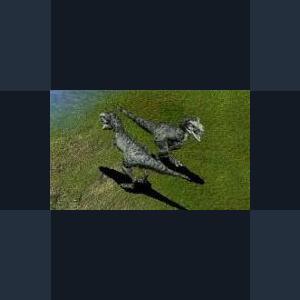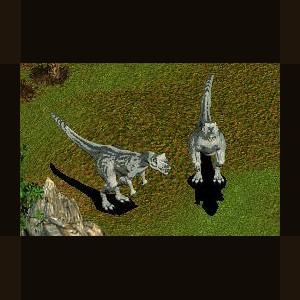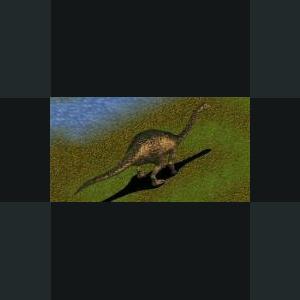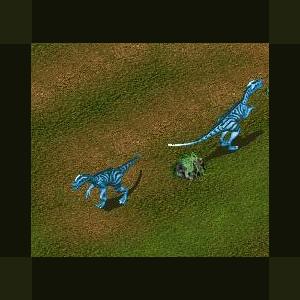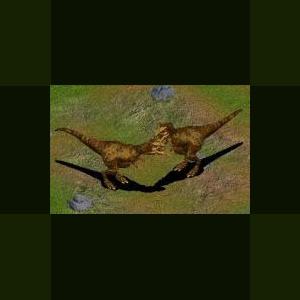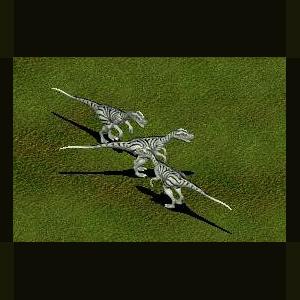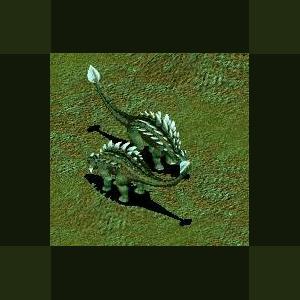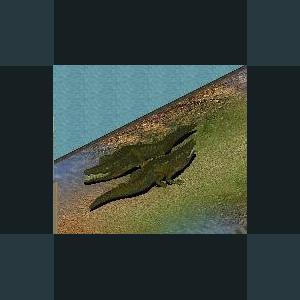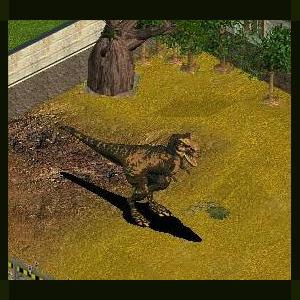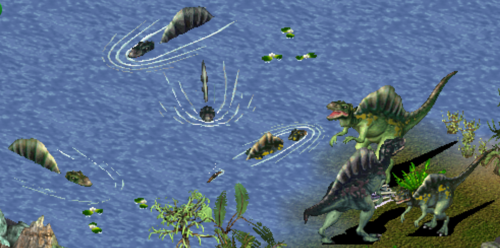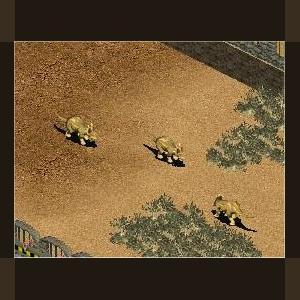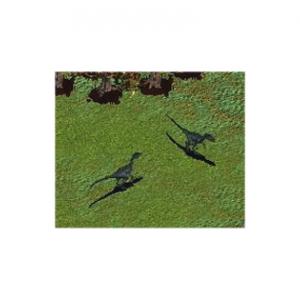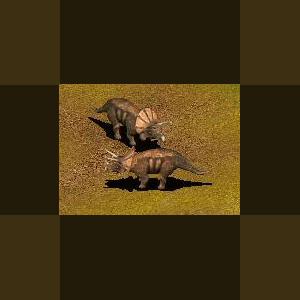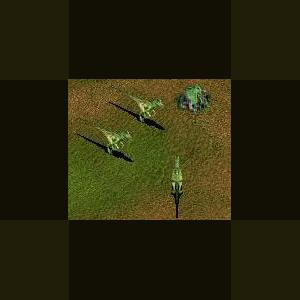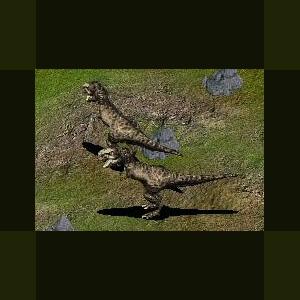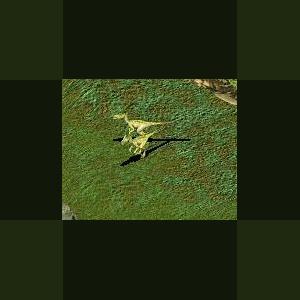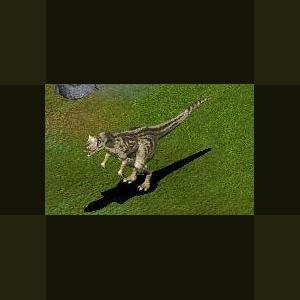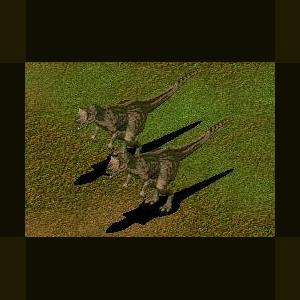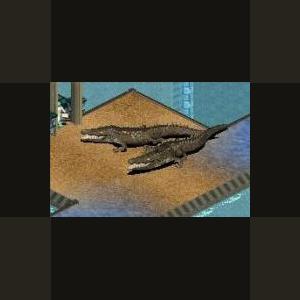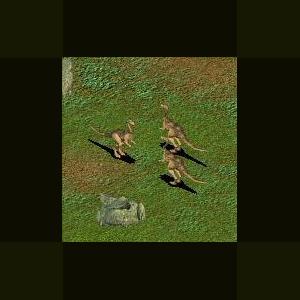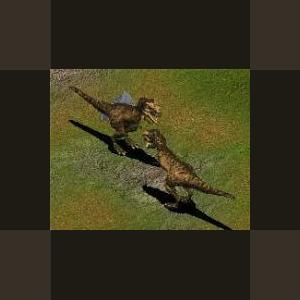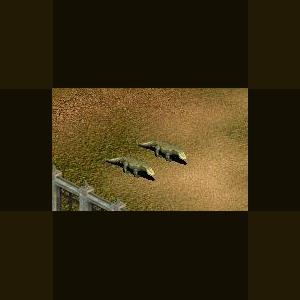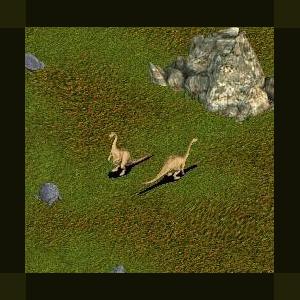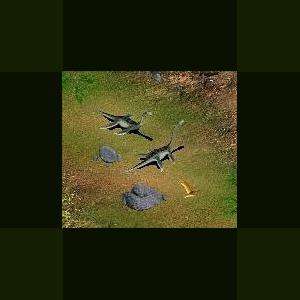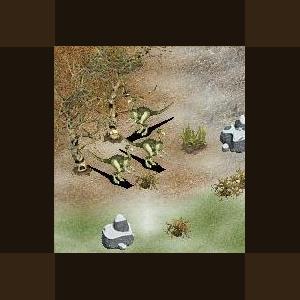Dinosaurs
Creatures from another age
241 files
-
Aviatyrannis by Moondawg
By Guest
Aviatyrannis is a genus of tyrannosaurid dinosaur from the Kimmeridgian stage of the Late Jurassic found in Portugal.
It was described by Oliver Rauhut in 2003. The name means "Jurassic grandmother tyrant". It is one of the oldest tyrannosaurs ever found, the oldest being Guanlong (or Iliosuchus if it is indeed tyrannosauroid).
Aviatyrannis was perhaps a contemporary of another ancient tyrannosaur, the American Stokesosaurus. Aviatyrannis was even originally assigned to Stokesosaurus, and its fragmentary remains maintain the question of their synonymity open.
Like other early tyrannosaurs, Aviatyrannis was rather small. The holotype, for example, is an ilium only 90 millimeters long. The type species, Aviatyrannis jurassica, was described by Rauhut in 2003.
Inspired by the Zoo Tek Brains Trust
226 downloads
Updated
-
Giganotosaurus by Moondawg
By Guest
Giganotosaurus (meaning 'giant southern lizard', derived from the Ancient Greek gigas meaning 'giant', notos meaning 'south wind' and saurus meaning 'lizard') was a genus of carcharodontosaurid dinosaur that lived 93 to 89
Giganotosaurus carolinii was named for Ruben Carolini, an amateur fossil hunter, who discovered the fossils in the deposits of the Rio Limay Formation of Patagonia, southern Argentina, in 1993. It was published by Rodolfo Coria and Leonardo Salgado in the journal Nature in 1995.
The holotype specimen's (MUCPv-Ch1) skeleton was about 70% complete and included the skull, pelvis, leg bones and most of the backbone. It is estimated around 12.2-12.5 m (40-41 ft) in length. A second specimen , 8% larger, has also been recovered. This largest Giganotosaurus specimen is estimated to represent an individual 13.2 m (43.3 ft) long, that weighed 6.2 tons. Giganotosaurus might have had the longest known skull for a theropod dinosaur, with the holotype's skull estimated at 1.80 m (6 ft) and the second specimen's estimated at 1.95 m (6.3 ft).[6] Giganotosaurus surpasses Tyrannosaurus rex in length by almost a meter (the upper length estimate for T. rex is 13 m).
Giganotosaurus, along with relatives like Tyrannotitan, Mapusaurus and Carcharodontosaurus, are members of the carnosaur family Carcharodontosauridae. Both Giganotosaurus and Mapusaurus have been placed in their own subfamily Giganotosaurinae by Coria and Currie in 2006 as more carcharodontosaurid dinosaurs are found and described, allowing interrelationships to be calculated
G. carolinii was slightly larger than T. rex but had a much smaller brain that was the size and shape of a banana. Its teeth were built more for cutting and slicing rather than crushing bones. A well-developed olfactory region means that it probably had a good sense of smell. Its skull, although large, had a slender build.
355 downloads
Updated
-
Rhoetosaurus by Moondawg
By Guest
Rhoetosaurus ("Rhoetos lizard"), named after Rhoetus, a Titan in Greek Mythology, was a genus of Sauropod dinosaur from the Jurassic (Middle Jurassic) of what is now eastern Australia.
Rhoetosaurus is estimated to have been about 12-15 metres long.
In 1924, Heber Longman, self-trained paleontologist at (and later director of) the Queensland Museum in Brisbane, learnt of a large fossil reptile skeleton exposed on Durham Downs Station near Roma in central Queensland. The station manager, Arthur Browne, forwarded fragments of bone to Longman, so and was honoured with the dinosaur's specific name brownei.
The initial collection was of 22 tail vertebrae, including a series of 16 consecutive bones, and other fragmentary hindlimb pieces. Soon after Longman announced the new discovery, he visited the station and arranged for more material of the same skeleton to be sent to the Queensland Museum. These included additional vertebrae from the thoracic area, bits of rib, more caudals and more of the femur and pelvis as well as a cervical vertebra.
Further material was collected by Mary Wade and Alan Bartholomai in 1975, and still more by Drs. Tom Rich, Anne Warren, Zhao Xijin, and Ralph Molnar. This additional material includes more ribs, another possible cervical vertebrae, and most of right hind limb, which is currently under study. To date, the end of the tail, forelimbs nor skull has not been found.
Along with Austrosaurus, Rhoetosaurus is among the two best-known sauropods thus far discovered in Australia, as well as for the Jurassic of Gondwana. Rhoetosaurus is presently the most complete Australian sauropod.
Inspired by the Zoo Tek Brains Trust
75 downloads
Updated
-
Atlascopcosaurus by Moondawg
By Guest
Atlascopcosaurus
Atlascopcosaurus (meaning "Atlas Copco lizard") is the name given to a genus of hypsilophodont dinosaur. It lived in what is now Australia; the type specimen, Atlascopcosaurus loadsi, was found at Dinosaur Cove in Victoria. It was about 2-3 metres (6.5-10 ft) long and weighed roughly 125 kg. It lived during the early Cretaceous (Aptian-Albian), but not much else is known about it; the genus is based on a mostly incomplete skeleton (the holotype consists of a piece of maxilla and teeth).
It was named after the Atlas Copco Company who had provided equipment for the expeditions that discovered this dinosaur in 1984. The project revealed 85 fossil bone fragments. This opened the door for more excavation and, along with other companies, Atlas Copco helped excavate about 60 metres of tunnel over 10 years.
The species name, loadsi, refers to William Loads, the state manager for Atlas Copco at the time, who assisted during the dig.
412 downloads
Updated
-
Albertosaurus by Moondawg
By Guest
Albertosaurus (pronounced ; meaning 'Alberta lizard') is a genus of tyrannosaurid theropod dinosaur that lived in western North America during the Late Cretaceous Period,
As a tyrannosaurid, Albertosaurus was a bipedal predator with tiny, two-fingered hands and a massive head with dozens of large, sharp teeth. It may have been at the top of the food chain in its local ecosystem. Although relatively large for a theropod, Albertosaurus was much smaller than its more famous relativeTyrannosaurus, probably weighing less than 2 metric tons.
Fossils of more than thirty individuals have been recovered, providing scientists with a more detailed knowledge of Albertosaurus anatomy than is available for most other tyrannosaurids. The discovery of 22 individuals at one site provides evidence of pack behavior and allows studies of ontogeny and population biology which are impossible with
lesser-known dinosaurs
432 downloads
Updated
-
Ceratosaurus by Moondawg
By Guest
This therapod had a pair of bony ridges above its eyes and a horn on its snout. These were probably used by males when fighting for a mate.
Ceratosaurus (cera-TO-saur-US ) meaning 'horned lizard', in reference to the horn on its nose (Greek keras/keratos meaning 'horn' and sauros meaning 'lizard'), was a large predatory dinosaur from the Late Jurassic Period, found in the Morrison Formation of North America, in Tanzania and Portugal. It was characterized by large jaws with blade-like teeth, a large, blade-like horn on the snout and a pair hornlets over the eyes. The forelimbs were powerfully built but very short. The bones of the sacrum were fused (synsacrum) and the pelvic bones were fused together and to this structure (Sereno 1997) (i.e. similar to modern birds). A row of small osteoderms was present down the middle of the back.
351 downloads
Updated
-
Bissektipelta by Moondawg
By Guest
Bissektipelta is an ankylosaurid dinosaur from the Upper Cretaceous of Uzbekistan. The holotype and only known specimen was collected from the Bissekty Formation (lateTuronian-Coniacian).
The holotype consists of a braincase and incomplete skull roof, along with isolated teeth and osteoderms. Originally, this material was referred to the genus "Amtosaurus", but was reassigned to a new taxon when that genus was declared a nomen dubium. Bissektipelta is presently monospecific, containing only B. archibaldi. The holotype was collected in September of 1998 by the joint Usbek-Russian-British-American-Project. This specimen can be distinguished from "A. magnus" in having three exits for N. hypoglossus instead of two, by the lesser angle between ventral surfaces of basisoccipital and basisphenoid, and by the more caudally situated basispterygoid processes.
421 downloads
Updated
-
DinoCroc by Moondawg
By Guest
DinoCroc
Dinocroc is a 2004 horror film about a prehistoric carnivore, Sarcosuchus imperator. It is resurrected in a genetics laboratory after being mixed with a modern day crocodile, resulting in a hybrid monstrosity that has a lot in common with the Spinosaurus. It escaped the lab in a run-of-the-mill American town, and begins devouring the residents.
305 downloads
Updated
-
Tarbosaurus by Ghirin
By Guest
Tarbosaurus Author: Ghirin
Tarbosaurus ("Terrible Lizard") was a large tyrannosaurid from the Cretaceous period in Asia. This dinosaur was very similar to the North American Tyrannosaurs rex and some paleontologists consider it to be a species of Tyrannosaur, naming it Tyrannosaurus bataar.
*Inspired by the Zoo Tycoon Brains Trust at the Zoo Tycoon Evolved Forum.*
265 downloads
Submitted
-
Swimming Spinosaurus by Jymn
By Cricket
Would you look at that!
The Spinosaurus at your zoo has finally caught up with modern paleontological consensus and learned to swim. Nice work, guys. They're so happy they've got a derpy new land animation that plays occasionally (made from the fence-zap animation with all the electric shock taken out)
Also they're dimorphic: the ladies are dark crocodile-colours and the babies are dark with yellow spots--like baby crocodiles. The boys just have a slight color change to the inside of the mouth.
Available as a hack or as a new animal. The exhibit requirements are similar to the Combined Realism Hack but you may need to make a few adjustments.
Right now there aren't any 'special' animations in the water like snapping or thrashing. Maybe they'll learn some tricks over the summer...
134 downloads
Updated
-
Protoceratops by Ghirin
By Guest
Protoceratops ("Before the horned-faces") is well known from numerous skeletons, ranging from young animals to adults. It was a common dinosaur from Cretaceous Mongolia.
Reference:
The Illustrated Encyclopedia of Dinosaurs by Dougal Dixon. 2006
www.wikipedia.com
Created by Ghirin 2006
505 downloads
Updated
-
Ebony Velociraptor by Ghirin
By Guest
Ebony Velociraptor
Author: Ghirin
http://www.zoo-tek.com/forums/index.php?download=109
The ebony velociraptor is a melanistic variant of the velociraptor. In melanism, the high production of melanin leads to dark brown or black fur and/or skin. Melanistic variants are found in many different species ranging from fish to mammals and in some cases this color variant does not pose a major handicap to the individual (unlike albinism and leucism).
Melanistic animals tend to have higher survival rates in areas of dense foliage, where the darker pigment might provide better camouflage. This appears to be the case in felines such as black leopards and jaguars. In other instances, such as animals living in open country with little plant cover would be at a disadvantage because they would be more conspicuous to prey or predators.
Like modern animals, melanistic individuals occurred in dinosaur populations. Predators that lived in forested areas probably had
References:
Designer Reptiles and Amphibians. R.D. Bartlett and Patricia Bartlett, 2001.
Reptile and Amphibian Variants: Colors, Patterns, and Scales. H. Bernard Bechtel, 1995.
The Corn Snake Manual. Bill Love and Kathy Love, 2000.
Walker's Mammals of World. Nowak, 1999.
Created by Ghirin
202 downloads
Updated
-
Chasmosaurus by Moondawg
By Guest
Chasmosaurus (KAZ-mo-sawr-us) is a ceratopsid dinosaur genus from the Upper Cretaceous Period of North America.
Ceratopsians are split into two subfamilies by taxonomists; those with short frills
(centrosaurines), such as Centrosaurus and those with long frills (chasmosaurines), of
which Chasmosaurus was one. In addition to the larger frill, the long-frilled ceratopsians
typically had longer faces and jaws and it is suggested by some paleontologists that they
were more selective about the plants they ate. Long frills were a relatively late
development in dinosaur evolution, since even Chasmosaurus dates from the late Cretaceous
Period, 76 to 70 million years ago. The frill of Chasmosaurus has been described as
"heart-shaped", since its bone structure consists of two large 'loops' from a central bone.
Some finds include a number of smaller ossifications (called epoccipitals), which may have
grown from the perimeter of the frill. The frill may also have been brightly colored, to
draw attention to its size or as part of mating display. However, the frill was so large
and yet so flimsy (since it was mainly skin stretched between the bones) that it could not
have provided much functional defense. It is possible that it was simply used to appear
imposing or conceivably for thermoregulation. In the event of a chasmosaur herd being
attacked by a predator (such as Tyrannosaurus), the males could have formed a ring and,
with all the frills facing outwards, would have presented a formidable sight.
A drawing of Chasmosaurus.Like many ceratopsians, chasmosaurs had three main facial horns - one on the nose and two on the brow. Different fossil finds have produced inconclusive
results - one species of Chasmosaurus, named C. kaiseni, bore long brow horns, while C. belli had only short ones. Although these were initially named as different species, it now seems possible that the long horns belonged to males and the shorter horns to females.
Interestingly, a Chasmosaurus specimen recovered by Sternberg was accompanied by
fossilized skin.The skin appears to have had many bony knobs (osteoderms) in evenly spaced rows, with five or six sides per knob. Unfortunately, nothing can be learned about the coloration of Chasmosaurus from the known fossil skin samples.
Inspired by the Zoo Tek Brains Trust
238 downloads
Updated
-
Staurikosaurus by Moondawg
By Guest
Staurikosaurus ("Lizard of the Southern Cross") is a genus of early dinosaur from the Late Triassic of Brazil.
There exists only a single specimen of Staurikosaurus, recovered from the Paleontological Site Jazigo Cinco of the Santa Maria Formation in the geopark of paleorrota , Rio Grande do Sul, southern Brazil. The name refers to the star constellation "The Southern Cross", pictured in the coat of arms of Brazil and only visible in the southern hemisphere - when Staurikosaurus was described in 1970, it was unusual to find dinosaurs in the southern hemisphere. It was first described by Edwin Harris Colbert, working at the American Museum of Natural History. The rarity of Staurikosaurus remains may be a result of it being uncommon while alive, or because it lived in an environment like a forest, where fossils rarely form.
Staurikosaurus was a small theropod from the late Triassic Period, 225 million years ago - specifically the Carnian age. It is one of the earliest dinosaurs that is known. At just 2 metres in length (6.5 ft), 80 centimetres tall (31 in), and weighing just 30 kilograms (66 lb), Staurikosaurus was tiny in comparison to later theropods like Megalosaurus. Newer research seems to confirm that Staurikosaurus and the related Eoraptor and Herrerasaurus are definite theropods and evolved after the sauropod line had split from the Theropoda.
There exists very incomplete fossil record of Staurikosaurus, consisting most of the spine, the legs and the large lower jaw. However, dating from such an early period in the dinosaurs' history and being otherwise so primitive, most of Staurikosaurus' other features as being primitive also can be reconstructed. For example, Staurikosaurus is usually depicted with five toes and five fingers - very simple features of an unspecialised dinosaur. However, since the skeletal structure of the legs is known, it can be seen that Staurikosaurus was a quick runner for its size. It also had just two vertebrae joining the pelvis to the spine, a distinctly primitive arrangement. The tail would have been long and thin to balance the border - later sauropods had larger, shorter tails relative to their weight.
The recovered mandible suggests that sliding joint of the jaw allowed it to move backwards and forwards, as well as up and down. Thus smaller prey could be worked backwards towards Staurikosaurus' throat, along its small and backwards-curving teeth. This feature is common in theropods of the time, but disappears in later theropods who presumably had no need for efficiency in eating smaller prey
158 downloads
Updated
-
Stokesosaurus by Moondawg
By Guest
Stokesosaurus ("Stokes' lizard") was a small early tyrannosaur from the Late Jurassic period of Utah.
It was named after Utah geologist William Lee Stokes.
The holotype consists of a hip bone, originally thought to belong to the possible early
tyrannosaur Iliosuchus (Galton, 1976), as well as several vertebrae and a partial
braincase (Chure and Madsen, 1998). Another illium referred to this dinosaur (Foster and
Chure, 2000) is lost but may actually belong to the related Aviatyrannis, and a premaxilla
thought to belong to Illiosuchus (Madsen, 1974) is actually from Tanycolagreus.
Stokesosaurus and Tanycolagreus are about the same size, and it is possible that the
latter is a junior synonym of the former. However, the ilium (the best known element of
Stokesosaurus) of Tanycolagreus has never been recovered, making direct comparison
difficult.
Inspired by the Zoo Tek Brains Trust
156 downloads
Updated
-
Achillobator by Moondawg
By Guest
Achillobator (meaning "Achilles' warrior/hero") is a genus of dromaeosaurid theropod dinosaur from the late Cretaceous Period of what is now Mongolia.
Fossil bones of Achillobator were found mostly disarticulated, but associated, including a fragment of the upper jaw with teeth, as well as vertebrae from all sections of the spinal column, ribs, and bones from the shoulder, pelvis, forelimbs and hindlimbs. These remains were found in the Bayan Shireh Formation of Dornogovi Province, Mongolia, which dates to the Late Cretaceous epoch. The exact age is uncertain, with two competing hypotheses; based on comparisons with other formations, the Bayan Shireh fauna seems to correspond best with the Turonian through early Campanian stages of the Late Cretaceous, about 93 to 80 million years ago. However, examination of the magnetostratigraphy of the formation seems to confirm that the entire Bayan Shireh lies within the Cretaceous Long Normal, which lasted only until the end of the Santonian stage, giving a possible Cenomanian through Santonian age, or between 98 and 83 million years ago. Other dinosaurs found in the Bayan Shireh include Alectrosaurus, Segnosaurus, Talarurus, and Bactrosaurus
349 downloads
Updated
-
Acrocanthosaurus by Moondawg
By Guest
Acrocanthosaurus (pronounced ak-ro-KAN-tho-SAWR-us; meaning 'high-spined lizard') is a genus of allosauroid theropod dinosaur that existed in what is now North America during the mid-Cretaceous Period
The skull of Acrocanthosaurus, like most other allosauroids, was long, low and narrow. The weight-reducing opening in front of the eye socket (antorbital fenestra) was quite large, more than a quarter of the length of the skull and two-thirds of its height. The outside surface of the maxilla (upper jaw bone) and the upper surface of the nasal bone on the roof of the snout were not nearly as rough-textured as those of Giganotosaurus or Carcharodontosaurus. Long, low ridges arose from the nasal bones, running along each side of the snout from the nostril back to the eye, where they continued onto the lacrimal bones. This is a characteristic feature of all allosauroids. Unlike Allosaurus, there was no prominent crest on the lacrimal bone in front of the eye. The lacrimal and postorbital bones met to form a thick brow over the eye, as seen in carcharodontosaurids and the unrelated abelisaurids. Nineteen curved, serrated teeth lined each side of the upper jaw, but a tooth count for the lower jaw has not been published. Acrocanthosaurus teeth were wider than those of Carcharodontosaurus and did not have the wrinkled texture that characterized the carcharodontosaurids. The dentary (tooth-bearing lower jaw bone) was squared off at the front edge, as in Giganotosaurus, and shallow, while the rest of the jaw behind it became very deep. Acrocanthosaurus and Giganotosaurus shared a thick horizontal ridge on the outside surface of the surangular bone of the lower jaw, underneath the articulation with the skull.
484 downloads
Updated
-
Carcharodontosaurus by Moondawg
By Guest
Carcharodontosaurus was a gigantic carnivorous carcharodontosaurid dinosaur that lived around 98 to 93 million years ago, during the Cretaceous Period.
It was nearly as long as Tyrannosaurus, growing to an estimated 11.1-13.5 meters (36-44 feet) and weighing up to 2.9 metric tons. The name Carcharodontosaurus means 'shark lizard', after the shark genus Carcharodon (from the Greek karcharo meaning 'jagged' and odonto meaning 'teeth') and sauros, meaning 'lizard'
Carcharodontosaurus was a carnivore, with enormous jaws and long, serrated teeth up to eight inches long. Paleontologists once thought that Carcharodontosaurus had the longest skull of any of the theropod dinosaurs. However, the premaxilla and quadrate bones were missing from the original African skull, which led to misinterpretion of its actual size by researchers. A more modest length of 1.6 meters (5.2 ft) has now been proposed for C. saharicus, and the skull of C. iguidensis is reported to have been slightly larger at 1.75 m in length (5.5 ft). Still, the honor of the largest theropod skull now belongs to another huge carcharodontosaurid dinosaur, the closely related Giganotosaurus (with skull length estimates up to 1.95 m) (6.3 ft).
The Endocranial cast, of the impression of the brain on the inside of the skull, and inner ear anatomy of Carcharodontosaurus saharicus resembled modern Crocodylia.The size of the cerebrum relative to the total brain was similar to modern reptiles, but small relative to coelurosaurian theropods and birds.
Carcharodontosaurus fossils were first found by Charles Depéret and J. Savornin in North Africa in 1927. Originally called Megalosaurus' saharicus(many theropods were once erroneously referred to as Megalosaurus), its name was changed in 1931 by Ernst Stromer von Reichenbach to that used today. Stromer named Carcharodontosaurus "for its mainly Carcharodon-like teeth", which were "not recurved, almost bilaterally symmetrical but with convex edges." These first fossils of Carcharodontosaurus were destroyed during World War II. However, cranial material from a Carcharodontosaurus was again discovered in Morocco in 1996 by paleontologist Paul Sereno. Stephen Brusatte and Paul Sereno reported a second species of Carcharodontosaurus, differing from C. saharicus in some aspects of the maxilla and braincase. This second species, which was discovered in Niger in 1997, was named C. iguidensis in December of 2007.
269 downloads
Updated
-
Purussaurus by Moondawg
By Guest
Purussaurus was a giant caiman living in South America, 20 million years ago (Miocene). It is only known from skull material found in Peruvian Amazonia.
The skull is about 1.5 meters (5 ft), and paleontologists estimate that the whole body would have measured around 15 meters (50 ft), which means that Purussaurus is one of the largest crocodilians known to have ever existed. Two other extinct crocodilians, Sarcosuchus and Deinosuchus, have similar proportions, but both are geologically much older, dating from the Early and Late Cretaceous, respectively. During the summer of 2005, a franco-peruvian expedition (the Fitzcarrald expedition) found new fossils of Purussaurus in Amazonia (600 km from Lima).
Purussaurus was a giant caiman living in South America during the Miocene epoch, 8 million years ago. It is known from skull material found in the Brazilian, Colombian and Peruvian Amazonia, besides in the north of Venezuela. The skull is about 1.5 meters (5 ft) long, and paleontologists estimate that the whole body would have measured around 12 meters, which means that Purussaurus is one of the largest crocodilians known to have ever existed. Two other extinct crocodilians, Sarcosuchus and Deinosuchus, have similar proportions, but both are geologically much older, dating from the Early and Late Cretaceous, respectively, and another from around the same era, the Rhamphosuchus, is also estimated to be of similar size. During the summer of 2005, a Franco-Peruvian expedition (the Fitzcarrald expedition) found new fossils of Purussaurus in Amazonia (600 km from Lima).
308 downloads
Updated
-
Agilisaurus by Moondawg
By Guest
Acrocanthosaurus (pronounced ak-ro-KAN-tho-SAWR-us; meaning 'high-spined lizard') is a genus of allosauroid theropod dinosaur that existed in what is now North America during the mid-Cretaceous Period
The skull of Acrocanthosaurus, like most other allosauroids, was long, low and narrow. The weight-reducing opening in front of the eye socket (antorbital fenestra) was quite large, more than a quarter of the length of the skull and two-thirds of its height. The outside surface of the maxilla (upper jaw bone) and the upper surface of the nasal bone on the roof of the snout were not nearly as rough-textured as those of Giganotosaurus or Carcharodontosaurus. Long, low ridges arose from the nasal bones, running along each side of the snout from the nostril back to the eye, where they continued onto the lacrimal bones. This is a characteristic feature of all allosauroids. Unlike Allosaurus, there was no prominent crest on the lacrimal bone in front of the eye. The lacrimal and postorbital bones met to form a thick brow over the eye, as seen in carcharodontosaurids and the unrelated abelisaurids. Nineteen curved, serrated teeth lined each side of the upper jaw, but a tooth count for the lower jaw has not been published. Acrocanthosaurus teeth were wider than those of Carcharodontosaurus and did not have the wrinkled texture that characterized the carcharodontosaurids. The dentary (tooth-bearing lower jaw bone) was squared off at the front edge, as in Giganotosaurus, and shallow, while the rest of the jaw behind it became very deep. Acrocanthosaurus and Giganotosaurus shared a thick horizontal ridge on the outside surface of the surangular bone of the lower jaw, underneath the articulation with the skull.
235 downloads
Updated
-
Alioramus by Moondawg
By Guest
Alioramus ( meaning 'different branch') is a genus of tyrannosaurid theropod dinosaur from the Late Cretaceous Period of Asia.
The type and only species, A. remotus, is known from a partial skull and three metatarsals recovered from Mongolian sediments which were
deposited in a humid floodplain between 70 to 65 million years ago. These remains were
named and described by Russian paleontologist Sergei Kurzanov in 1976. Its relationships
to other tyrannosaurid genera are unknown, but some experts believe Alioramus is closely
related to the contemporaneous Tarbosaurus, or is a juvenile of that genus.
While very little skeletal material is known, Alioramus was probably bipedal like most
theropods, and its sharp teeth indicate that it was a carnivore. It was smaller than
tyrannosaurids like Tarbosaurus and Tyrannosaurus, but its adult size is difficult to
estimate since it is known mainly from a skull, which may belong to a juvenile. Alioramus
is characterized by the row of five bony crests along the top of its snout, and also has
more teeth than any other tyrannosaurid. Its skull is lower than those of other
tyrannosaurids, but this might be a juvenile feature.
Alioramus was estimated at between 5 and 6 meters (16.5 to 20 ft) in length when
originally described by Sergei Kurzanov in 1976. Kurzanov, however, did not correct for
lengthening of the skull by deformation during fossilization, which may indicate a shorter
overall body length for this individual. If this specimen is a juvenile, then adult
Alioramus would have reached greater lengths, but no confirmed adult specimens are known.
Inspired by the Zoo Tek Brains Trust
285 downloads
Updated
-
Baurusuchus by Moondawg
By Guest
Baurusuchus is an extinct genus of baurusuchid mesoeucrocodylian from the Late Cretaceous of South America.
325 downloads
Updated
-
Anchisaurus by Moondawg
By Guest
Anchisaurus (from Greek anchi-; "near, close" + Greek sauros; "lizard", probably referring to Marsh's interpretation of it as intermediate between more primitive dinosaurs [at the time Palaeosaurus was an example of what was thought to be a primitive dinosaur] and more derived dinosaurs) is a genus of prosauropod dinosaur. The name Anchisaurus was coined as a replacement name for Amphisaurus, which was a replacement name for Hitchcock's Megadactylus, both of which had already been used for other animals.
The first discovery of Anchisaurus remains was made before anything was known about dinosaurs and it was probably the first dinosaur discovery in North America. When, in 1818, some large bones were discovered in Connecticut, USA, it was assumed that they were of human origin.Gradually, as a result of further finds in Massachusetts, the number of these bones began to accumulate and, by 1855, they were at least recognized as reptilian.
Hitchcock collected these bones under the name Megadactylus in 1865. Unfortunately, the name was in use, and the famous paleontologist Othniel Charles Marsh renamed it Anchisaurus in 1885. Remains thought to belong to this genus were found in South Africa and China, adding to the theory that these land masses were at the time joined in one super-continent, Pangaea, but these assignments have been contentious (Gyposaurus). A recovery from Nova Scotia may also be an Anchisaurus but this is unconfirmed.
Today, parts of Anchisaurus' skeleton are still missing. Reconstructions usually assume that the tail and neck were prosauropod-like. Recent analyses, however, put Anchisaurus firmly at the base of the Sauropoda, making it the most basal known sauropod.
Anchisaurus was a rather small dinosaur, with a length of just over 2 metres (6.6 ft), which helps explain why it was once mistaken for human bones. It probably weighed around 27 kilograms (60 lb). However, Marsh's species A. major (also known as Ammosaurus) was larger, from 2.5 to 4 metres (8 ft 2 in to 13 ft 1 in) and some estimates give it a weight of up to 70 pounds (32 kg). All species of Anchisaurus lived during the Early Jurassic Period; more specifically, the Pliensbachian to Toarcian ages, 200 to 188 million years ago.
Digesting plant matter is a much more intensive biochemical process than digesting meat. This herbivore swallowed gastroliths (gizzard stones) to help break down the food in its stomach. Herbivorous dinosaurs needed a huge gut. Since this had to be positioned in front of the pelvis, balancing on two legs became increasingly difficult, as dinosaurs became larger and they gradually evolved into the quadrupedal position that characterizes the later sauropods such as Diplodocus. Prosauropods represented a middle phase between the earliest bipedal herbivores and the later giant sauropods. Although it was not itself a prosauropod, Anchisaurus was mostly typical of this group, which flourished briefly during the late Triassic and early Jurassic. Anchisaurus teeth, used to rip food, were shaped like spoons. It had fewer and more widely spaced teeth than true prosauropods, and as Peter Galton and Michael Cluver observed, narrower feet. Anchisaurus would have spent most of its time on four legs but could have reared up on its hind legs to reach higher plants.
On the other hand, some paleontologists believe Anchisaurus may also have eaten meat, as it was in the transition between these two ultimately distinct groups. The teeth were blunt but with file-like edges, suggesting mostly plant matter was eaten and the jaw hinge was arranged in a way not entirely suited for tearing meat. Nevertheless, there is still some debate. The thumb had a large claw and the large eyes were not entirely on the side (as would be expected in an animal of a natural prey species).
As a quadrupedal/bipedal crossover, Anchisaurus had to have multi-purpose front legs. As 'hands', they could be turned inwards and be used for grasping. It had a simple reversible first 'finger', similar to a 'thumb'. As feet, the five toes could be placed flat against the floor and were strong at the ankle. This unspecialized design is typical of the early dinosaurs.
Due to its primitive appearance, Anchisaurus was previously classified as a prosauropod, a member of a group of animals related to or ancestral to the sauropods. Recent investigations show that Prosauropoda forms a monophyletic sister-group to Sauropoda and that Anchisaurus is instead a very basal sauropod.
Marsh was originally happy with Hitchcock's name Megadactylus but this name was already taken. Therefore, he renamed it Amphisaurus in 1882. However, this name was also already in use and therefore, it became Anchisaurus in 1885.
The type species is Hitchcock's A. polyzelus. Marsh's A. major ("greater near lizard") is still often considered a valid species (as Ammosaurus) but his A. colurus (1891), once known as Yaleosaurus (von Huene, 1932), is now generally accepted as a female A. polyzelus, and his A. solus of 1892 is now reclassified as Ammosaurus major. However, Ammosaurus major itself may well be a synonym of A. polyzelus.
Broom named Gyposaurus capensis in 1911, from the bones discovered in South Africa but Peter Galton officially renamed it A. capensis in 1976. This species has since been reclassified again and is probably a juvenile of Massospondylus carinatus. G. sinensis was also referred here, but appears to be a distinct animal. Other specimens are still awaiting reclassification. This confusion is typical of the first dinosaurs to be discovered, when classification was not considered as important and precise a process as today.
331 downloads
Updated
-
Ceresiosaurus by Moondawg
By Guest
Ceresiosaurus
Ceresiosaurus, meaning "Lizard of Ceres", is an extinct genus of aquatic sauropterygian reptile belonging to the nothosaur order. It was about 4 m (13 ft) long and its fossils have been found in Europe, and was named by Bernhard Peyer in 1931.
Ceresiosaurus existed during the middle Triassic period during the Anisian stage.
Ceresiosaurus was much more elongated than its relatives, and had fully developed flippers with no trace of visible toes. The finger bones in its flippers had multiplied (hyperphalangy) and elongated, giving the reptile much longer flippers than most nothosaurs. Ceresiosaurus's flippers greatly resembled those of the later plesiosaurs, an aquatic reptile family of which the nothosaurs were an early offshoot. Also noteworthy of Ceresiosaurus was that its skull is the shortest known of any nothosaur, giving it an appearance that made it the most plesiosaur-looking of the nothosaurs.
Although possessing a long neck and tail, Ceresiosaurus may not have been a reptile that swam via undulation; analysis of the bone structure in regards to the hips and powerful tail suggest that it instead propelled itself through the water much like a penguin. The evidence of pachypleurosaurs in the preserved stomach of Ceresiosaurus remains lend credence to the theory of it being a fast swimmer.
Olivier Rieppel suggested that Ceresiosaurus is a synonim of Lariosaurus
275 downloads
Updated
-
Leaellynasaura by Moondawg
By Guest
Leaellynasaura
Leaellynasaura was a small herbivorous ornithopod dinosaur of about 60-90 cm in length from the earliest Cretaceous, first discovered in Dinosaur Cove, Australia.
It was an Australian polar dinosaur. Strangely enough, at this period in time, Victoria would have been well within the Antarctic Circle, which is now very cold. This means that Leaellynasaura was living and apparently thriving much further south than any reptile could today. This is particularly relevant due to Cryolophosaurus being discovered in Antarctica, thus further suggesting the idea that dinosaurs could live under conditions which were once thought unsuitable for their kind. It is possible that the sun would not have risen for several weeks or months in the winter, depending on latitude, which means that Leaellynasaura would have had to live in the dark for perhaps months at a time. This is particularly relevant to the fact that Leaellynosaura had very big eyes and its brain had large optic lobes, as if it had evolved to be routinely active in the dark.Evidence found on the coast of western Victorian coastline suggests that polar dinosaurs, such as Leaellynasaura, may have dug burrows to nurture their young during the polar winter.
Regardless, the fact that it lived in extremely cold temperatures led many scientists to believe that Leaellynasaura was warm-blooded.
No complete skeletons have been found of Leaellynasaura. The species is known from many isolated limb bones, ribs, vertebrae, jaws, teeth and one partial skull.
The type species is Leaellynasaura amicagraphica. It was described in 1989. It was named after Leaellyn Rich, the daughter of the palaeontologist couple Tom Rich and Patricia Vickers-Rich who discovered it. Leaellynasaura was a hypsilophodont, a rather basal ornithopod. Like all ornithopods, it was a herbivore.
308 downloads
Updated

